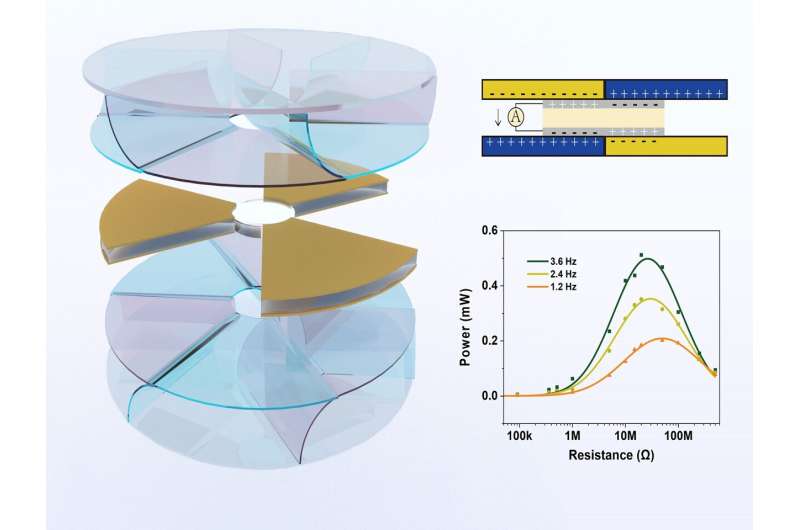Improving the efficiency of nanogenerators that harvest static electricity

Triboelectric energy is the scientific term for static electricity, or the energy that is created when two surfaces rub against each other. Electrons are exchanged between the two surfaces, charging one of the surfaces after they are separated.
For example, if a balloon is rubbed against hair, it will cling to a wall. Or if clothes in the dryer rub together, you may see sparks as you pull them apart. Triboelectric generators are mechanical energy harvesters that can generate electricity from two surfaces rubbing against each other. These tiny power generators can be used to power wearable electronic devices, sensors, and other advanced technologies.
In a new paper, researchers theorize a new way to design triboelectric nanogenerators with a constant inherent capacitance. Currently, these nanogenerators use a time-dependent inherent capacitance, but research suggests that this change could increase their energy conversion efficiency.
The paper was published on October 26 in Nano Research.
"Triboelectric nanogenerators can provide a feasible way to convert mechanical energy into electricity," said Youfan Hu, a professor at the School of Electronics at Peking University in China. "With improved efficiency and sensitivity, even very weak mechanical energy 'hidden' in the environment can be caught and utilized."
Capacitance is the ability of the nanogenerator's capacitor to store electric charges. To prove that the constant inherent capacitance could work, researchers first developed a mathematical model to analyze the potential of the triboelectric nanogenerators with constant inherent capacitance. Then the researchers fabricated a version of the nanogenerator in order to test its efficiency and compare it to existing time-dependent inherent capacitance.
The capacitors were charged using three different styles of power conditioning circuits to test the performance of the two different triboelectric nanogenerators.
They found that both triboelectric nanogenerators worked better on a full wave power circuit, but that the constant inherent capacitance triboelectric nanogenerators were able to store approximately two times the charge as the time-dependent inherent capacitance triboelectric nanogenerators.
This gives the constant inherent capacitance triboelectric nanogenerators a big advantage. They also found that this form of nanogenerator could charge very quickly.
"The results of our study show that triboelectric nanogenerators with a constant capacitance design are more efficient for harvesting mechanical energy from the environment and delivering the load," said Hu.
Finally, to prove how this type of triboelectric nanogenerator could be used in a real-world application, researchers create an anemometer based on their technology. An anemometer measures wind speed and direction.
When the kinetic energy of the wind moved the cups on the anemometer, the triboelectric nanogenerator was able to turn that information into electric signal , which could be processed as the measurements of the wind speed. The anemometer was able to process the information in real-time and send it to the researchers.
This style of triboelectric nanogenerator is also easy to manufacture and easy to design, so looking ahead, researchers will be studying how to make the device even more practical so it can be applied to a wide range of devices. They will also study how to improve its efficiency even more. "The next step is to miniaturize the device and optimize the power management circuits. Ultimately, triboelectric nanogenerators will be able to serve in an integrated electronic system with a small footprint," said Hu.
More information: Lanyue Gan et al, Triboelectric nanogenerators with a constant inherent capacitance design, Nano Research (2022). DOI: 10.1007/s12274-022-5054-3




















